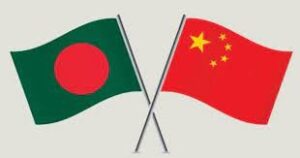
Pic Courtesy: Internet
Over the past five years, a significant improvement in areas of economic and defence cooperation has been observed between Bangladesh and China.
China has been following the policy of generous economic assistance, gaining considerable support within Bangladesh, both politically and among the general public.
Bangladesh is tending to become more authoritarian in recent times. China’s unwavering support for the government has also played a pivotal role in fostering this alignment. On the other hand emphasis on democratic values by the USA has strained their relations to some extent.
Deepening Economic Cooperation
Trade. Since 2017, Bangladesh has deepened its engagement with China. China has become Bangladesh’s largest trading partner.
Infrastructure. China has already invested around USD $9.75 billion in transportation projects in Bangladesh (including ongoing initiatives such as the Padma Bridge Rail Link, Bangabandhu Tunnel, and Dasher Kandi Sewerage Treatment Plant, etc).
FDI. China has also emerged as the largest source of foreign direct investment (FDI) in Bangladesh. It has also ranked as the top foreign investor in Bangladesh in 2022, with 104 investors operating in eight export-processing zones.
Duty-Free Access. From July 2020, China has granted duty-free access to 97 per cent (later increased further) of Bangladeshi products entering its market. This proved to be a significant development in bilateral trade relations.
Stronger Defence Ties
Arms Import. Bangladesh’s military partnership with China has also grown significantly and it has become China’s second-largest arms customer, after Pakistan.
Defence Cooperation. Defence cooperation between the two countries also includes military personnel training in China and collaboration in defence production.
Naval Capability Enhancement. In 2016, Bangladesh acquired submarines from China. In March 2023, Bangladesh’s Prime Minister unveiled the country’s submarine base (Constructed by China), named BNS Sheikh Hasina, in Cox’s Bazar. The facility has the capacity to accommodate six submarines and several warships. Currently, two Chinese-made submarines are stationed at the base, representing a significant development in Bangladesh’s naval capabilities.
Air Force Contract. China has recently signed a contract to supply 23 Hongdu K-8W intermediate training jets to the Bangladesh Air Force, further bolstering their military cooperation.
Geopolitical Aspects
Tug of war. In the post-COVID period and during the Russia-Ukraine war, geopolitical tension in the Indo-Pacific has also increased. Both China and the United States want Bangladesh in their camp.
Push and Pull. The United States had invited Bangladesh to join its Indo-Pacific Strategy, as a partner in the Indo-Pacific region. In response, China had warned that Bangladesh’s relations with China would be damaged if it joins the Quad, while also seeking Bangladesh’s participation in its Global Development Initiative and Global Security Initiative.
Strains. Bangladesh’s shift towards China, coupled with concerns over its dismissal of democratic values and human rights, has strained its relationship with the United States.
Drifting Apart. The international community has criticized the conduct of the 2014 and 2018 elections under the Awami League government. In response to human rights violations, the United States has imposed sanctions and implemented visa restrictions on individuals undermining democratic processes. Exclusion from the Biden Democracy Summit indicates a change in U.S. policy towards Bangladesh.
Pains and Gains. While the United States distances itself from the Awami League government, China is extending financial support and strengthening ties with Bangladesh.
Russian Angle. Russia is with China to counter the US influence in Bangladesh. Bangladesh and Russia have reached an agreement to use the Chinese yuan for payment in a nuclear power plant project (objected to by the USA).
Rohingya Crisis. The Rohingya crisis in Bangladesh poses a significant challenge to China’s geopolitical interests in the region. A peaceful resolution to this crisis, led by China, could further solidify its influence and foothold in Bangladesh. On the other hand, the United States has also taken steps to address the crisis, with the likelihood of an increase in its presence and influence in Bangladesh. The resolution of the Rohingya crisis holds implications for the geopolitical dynamics in the region, impacting the interests of both China and the United States.
Analytical Implications.
All key stakeholders in the Indo-Pacific such as the United States, China, Russia, Japan, and India are major development partners for Bangladesh.
Bangladesh’s shift towards China strained relations with the United States, and interests from India and Russia highlight the complex geo-political dynamics.
The choices made by Bangladesh in its alliances will have significant implications for its development and security. It will also have a far-reaching effect on the geopolitical dynamics of the region.
Through cooperation with Bangladesh, Beijing is also expanding its footprint in the Indo-Pacific.
Bangladesh’s increasing military partnership with China is encouraging anti-India sentiment in Bangladesh and will also put pressure on India.
Learning from Chinese engagement and its adverse effects, on other countries, Bangladesh will have to play with fire with caution.
Bottom Line
India should not lose Bangladesh to China (like Nepal).
Question
Are we enough in this regard?
Suggestions and value additions are most welcome
For regular updates, please register here
References and credits
To all the online sites and channels.
China in south Asia: Bangladesh tilting towards China by Shafi Mostafa on Southy Asian Voices.
Disclaimer:
Information and data included in the blog are for educational & non-commercial purposes only and have been carefully adapted, excerpted, or edited from sources deemed reliable and accurate. All copyrighted material belongs to respective owners and is provided only for purposes of wider dissemination.
